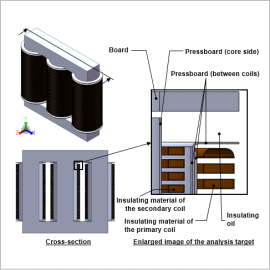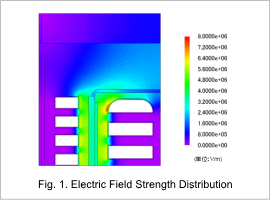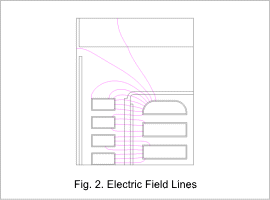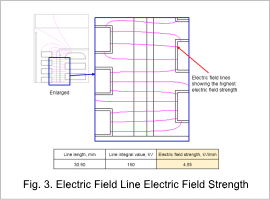*Please prepare a license ID and password for the license administrator.
*It is different from the service for JMAG WEB MEMBER (free membership). Please be careful.
Overview

A transformer is an electrical device that uses electromagnetic induction to convert the voltage level of alternating current power. Among transformers, power transformers that are used in power conversion have extremely high electric fields applied to their coils, so insulation technology like the winding structure, insulating materials, and insulation structure are vital in attaining miniaturization and higher capacity. In addition to normal power conversion, a transformer’s insulation structure has to be designed to be able to withstand lightning strikes and excess voltage during short circuits.
A transformer’s dielectric strength is dependent on the electric field intensity applied to the insulating material, so the electric field intensity needs to be examined before the safety factor for the insulation breakdown can be estimated.
In this example, how to obtain the electric field intensity distribution when a lightning strike or short circuit occurs and the assumed maximum voltage is applied to the winding.
A transformer’s dielectric strength is dependent on the electric field intensity applied to the insulating material, so the electric field intensity needs to be examined before the safety factor for the insulation breakdown can be estimated.
In this example, how to obtain the electric field intensity distribution when a lightning strike or short circuit occurs and the assumed maximum voltage is applied to the winding.
Electric Field Strength Distribution

Fig. 1 shows the electric field strength distribution when a potential difference is applied between the primary coil insulation and the secondary coil insulation.
From the figure it can be seen that a high electric field is generated. In order to accurately evaluate the dielectric strength, it is necessary to evaluate the electric field strength along the lines of electric force.
From the figure it can be seen that a high electric field is generated. In order to accurately evaluate the dielectric strength, it is necessary to evaluate the electric field strength along the lines of electric force.
Electric Field Lines

Fig. 2 shows the electric field lines when a potential difference is applied between the primary coil insulation material and the secondary coil insulation material.
Many electric field lines are generated between the primary coil insulation and the secondary coil insulation.
Many electric field lines are generated between the primary coil insulation and the secondary coil insulation.
Dielectric Strength Evaluation

The line integral values of the electric field along the electric field lines are obtained, and each of these values are divided the length of its associated electric field line and evaluated.
Among the electric field lines shown in Fig. 2, the electric field lines with the highest electric field strengths are shown in Fig. 3. Since the electric field strength is 4.85 kV/mm, which is below the specified dielectric strength of 10 kV/mm, it can be confirmed that this specified dielectric strength is not exceeded.
Among the electric field lines shown in Fig. 2, the electric field lines with the highest electric field strengths are shown in Fig. 3. Since the electric field strength is 4.85 kV/mm, which is below the specified dielectric strength of 10 kV/mm, it can be confirmed that this specified dielectric strength is not exceeded.


